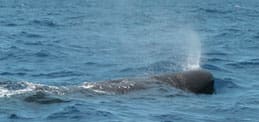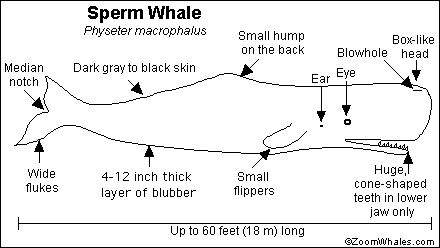Sperm Whales and Other Large Whales in Hawaii
Sperm Whales
Scientific Name: Physeter macrocephalus

The sounds of sperm whales have been recorded throughout the year off Oahu. Sperm whale abundance in Hawaii is estimated at 7,082 seemingly peaking in spring months.
Sperm whales remain one of the most mysterious of the great whales, living in remote deep waters.
“These are truly weird animals. Their heads account for over half their body length and the rest is all tail. They have tiny, mean but not unintelligent eyes and paddle-like flippers. As they shed their skin regularly they appear patchy, even shabby. On their bodies, remora [suckerfish] wriggle and slither with incredible agility and speed, gathering what food drifts by on this fairground ride to the deeps, for this is a creature designed to dive to ridiculous depths, where, in the pitch black of the abyssal deep, they hunt among other things, giant squid, architeuthis.” Christopher Swann
- They are the largest of the toothed whales, and are the “Monstro” of Pinocchio fame.
- Sperm whales have the largest and most complex brain on earth, housed within the largest head, yet have a very narrow lower jaw. They have teeth (all the same shape )only on the underslung lower jaw which fit into sockets on their upper jaw.
- Due to this fact, some scientists believe that sperm whale calves nurse through their blowholes!
- The dark skin of the sperm whale is similer to that of a prune!
- Unlike all other toothed whales, the sperm whale’s blow hole is not in the middle but off to the left side. The blow is a noisy, single stream that rises up to 50 feet (15 m) above the surface of the water and points forward and to the left of the whale at a 45° angle.
- Sperm whales prey mainly upon deep water (giant!) squid and fish.An adult Sperm Whale can eat about a ton of food each day.
- When foraging, they surface for about 10 minutes, then fluking up before diving for about 40-minutes
- Dives up to 2500m and possibly 3200m have been noted, as well as dives lasting as long as 138 min!
- Sperm whales are often seen logging and are relatively easy to approach in this state.
- Sperm whales are remarkable for their strong social bonds.
- The members of a pod protect the young, the sick and the injured. Groups of females with their young are common. This group structure allows a mother to dive very deeply to hunt while leaving her young calf, who is unable to dive very deeply, at the surface and protected by the pod.
- Frequently, other whales “assist” in the birthing process.
- As a likely form of communication and perhaps other functions, sperm whales usually breach during the few hours each day when they socialize with other sperm whales in a group at the sea’s surface.

Hawaii’s Large Whales – more rarely seen
BLUE WHALE (Balaenoptera musculus): Whaling catch data indicate that whales feeding along the Aleutian Islands may migrate to offshore waters north of Hawaii in winter. Under normal circumstances individual blue whales live to an age of 70 to 100 years. This makes the species vulnerable after a large collapse, as it must have evolved around a slow reproduction rate. It also means some of the blue whales alive today are the same whales that swam through the whalers’ net to safety, now forty years ago.
BRYDE’S WHALE (Balaenoptera edeni): Outside the main islands, Bryde’s whales do not migrate.
FIN WHALE (Balaenoptera physalus): Fin whales, sleek and fast animals, migrate into Hawaiian waters mainly in fall and winter, based on acoustic recordings off Oahu and Midway Islands. They are second in size only to the blue whale. The fin whale’s haw is black on the left side and white on the right.
MINKE WHALE (Balaenoptera acutorostrata): Minke whales have only been recently confirmed to occur seasonally around the Hawaiian Islands and their migration routes or destinations are not known.
SEI WHALE (Balaenoptera borealis): Previously, sei whales were estimated to have been reduced to 20% of their prewhaling abundance in the North Pacific. They appear to be more abundant in Hawaiian waters in the summer or fall, but the majority of sei whales would be expected to be at higher latitudes in their feeding grounds at this time of year. Hawai‘i may be a reproductive area for the endangered sei whale, whose breeding and calving ground locations remain unknown in the Pacific Ocean.
On rare occasions North Pacific right whales are observed in Hawaii
Our wildlife tours focus on education and conservation so that an interactive relationship can be maintained in the best interest of both humans and dolphins. We model admiration and deep respect for these wonderful mammals.

